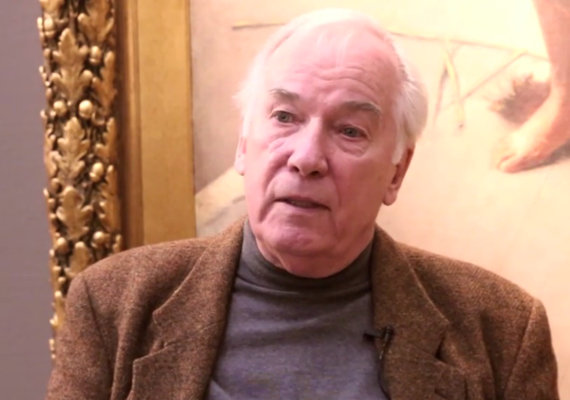Claude François • Director
“I filmed those paintings out of pleasure”
by Dimitra Bouras - Cinergie.be
- We met up with Belgian documentary director Claude François to discuss his latest film, Le Pavillon des Douze

A truly symbolic figure in the field of artistic documentary, Claude François has many films under his belt, ranging from Le Palais des Merveilles in 1981 to Désordre alphabétique in 2012, and also including Charles et Félicien in 1994. Today, however, marks a new adventure for him, something bold and intrepid, but above all else, something poetic: Le Pavillon des Douze [+see also:
trailer
interview: Claude François
film profile]. In this intimate (and imaginary) place, one can find a dozen pictorial works presented by various museums of the Wallonia-Brussels Federation. The objective is not to create a history of Belgian art, but rather to present these works, which combine diverse eras and styles, from a personal and original angle. François has not worked alone: he has surrounded himself with a group of French-speaking Belgian poets who discuss each of the works, and the viewer is invited to take a furtive peek at this kaleidoscope of voices and images.
Cinergie: In this film, you have not followed just one theme, but rather multiple themes. How did you choose them?
Claude François: I got carried away by feelings. I liked to visit the museums, look at the paintings and hold onto those of distinct ages and styles. The only pressure was to choose museums in Wallonia-Brussels. Normally, only one theme exists in films about art: an artist, a work, a movement or a concrete theme. However, here I have brought together some very different paintings, each in an individual museum, which I have called the Pavilion of the Twelve.
A collector's dream?
It's more comfortable than a collector’s dream because I do not have to worry about saving or conserving the paintings. A museum like this is within everyone's reach. I am a director, so I bring them together on film.
How did you make the selection?
I was very lucky because there were museums I did not know or did not know very well. In these museums, the curators guided me, and I was then able to discover painters who were usually overlooked. I went with preconceived ideas, thinking that I was going to choose one painter instead of another. In Charleroi, for example, I wanted to choose a well-known painter like Paulus that painted in the Borinage region, but the curator showed me another painter, Gilberte Dumont. In Mons, something similar occurred: the curator showed me two paintings I was not familiar with, two paintings that were totally different, so that’s how I ended up choosing an anonymous painter from the 16th century. In Liège, I opted for Le terril by Cécile Douard while I was walking through the rooms of the museum.
The painting by Théo Van Rysselberghe, Les filles du peintre Schlobach, I had already discovered a while beforehand while editing a previous film, Charles et Félicien, about Baudelaire and Rops. This painting was exhibited in La Boviere, in Liége, and since then it has followed me. I had also discovered the painting by Léon Frédéric a long time ago; it seemed very odd to me, since I had already done a bit about a triptych by Léon Frédéric, Les marchands de craie, a very realistic painting in comparison with this. He is a painter I have a soft spot for. He also has some unbelievable Symbolist paintings. However, there was no historical will on my part. I recorded those paintings out of pleasure; it was also a way to observe them a bit better and to allow the audience to see them in a different manner and under a particular visual focus.
Another distinctive feature of the film was to have poets write about the paintings.
Pierre Puttemans has been a friend of mine for a long time, and he was the first to suggest to me that he could write an original text. He also strongly recommended Claude Bauwens, but the only thing of his I knew was a compilation edited a while ago by the Daily-Bul. I had already read many of Guy Goffette's compilations of poems, essays and novels, and that's why I wanted him to take part in the film. André Stas recommended Eric Dejaeger to me for his drawings, while Corinne Hoex, a writer of poems and novels, suggested Jack Keguenne to me. I also discovered many whom I did not previously know. I wanted contemporary, French-speaking, Belgian poets. First, I asked them if they would be interested in embarking on this adventure. I made a detailed, precise graphic guide for each painting, and I asked them to choose the one they wanted to talk about. It is easier to write about a painting than it is to write based on its graphic guide or its visual narration - that is much more difficult. Another obstacle was the timing of each shot, the duration of the sequence dedicated to each painting, but even there I was flexible.
Read the interview in its entirety here.
In collaboration with
(Translated from French)
Did you enjoy reading this article? Please subscribe to our newsletter to receive more stories like this directly in your inbox.
















